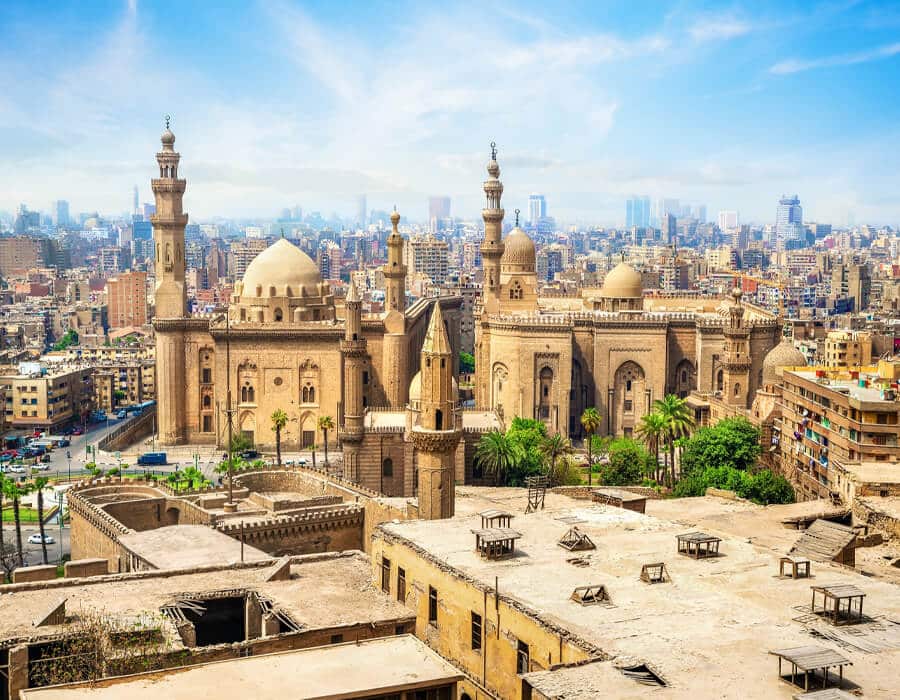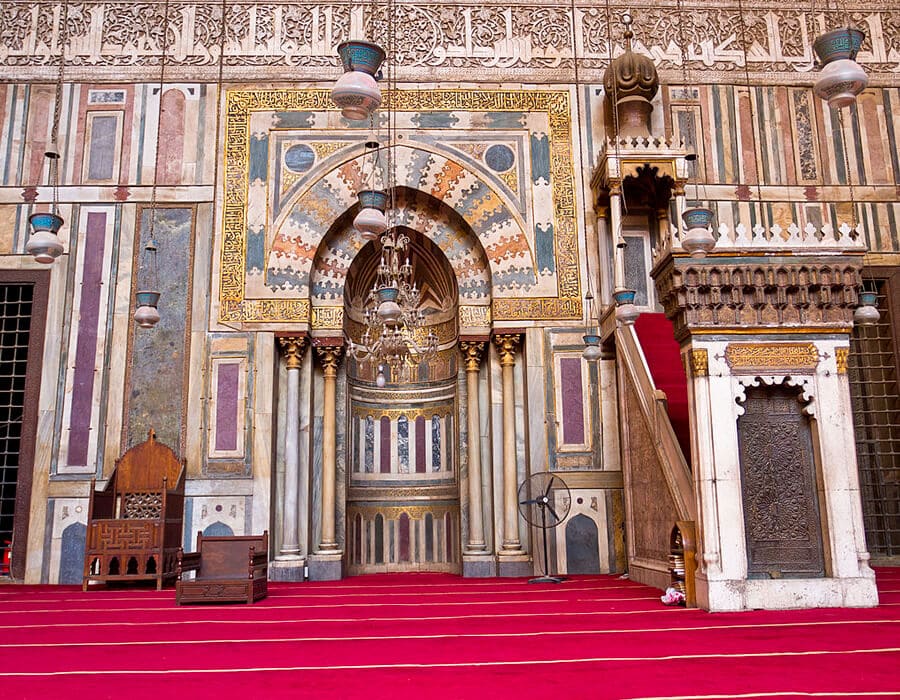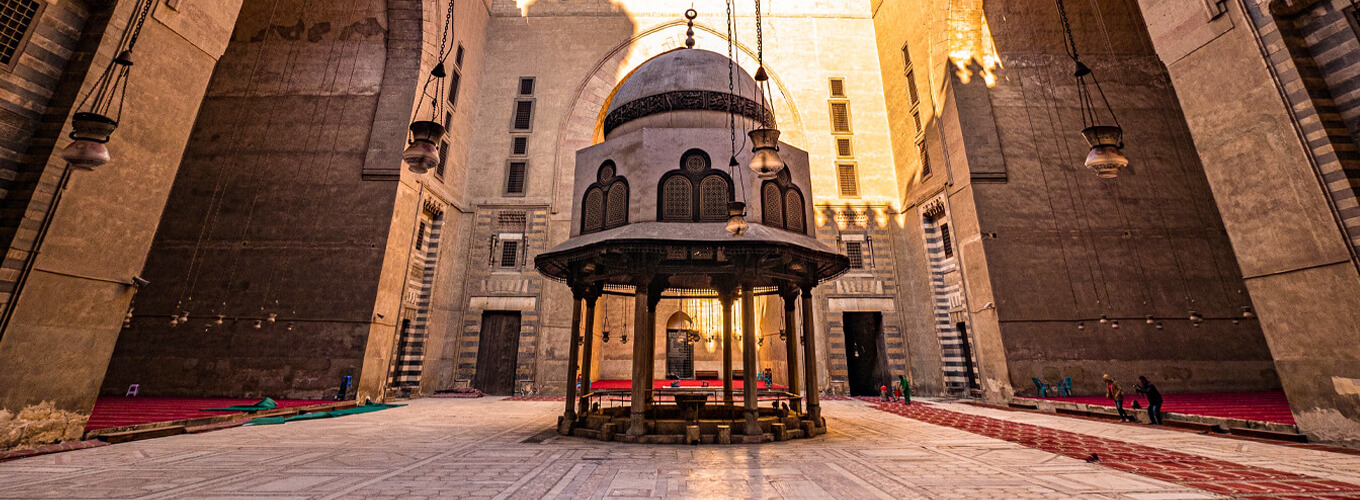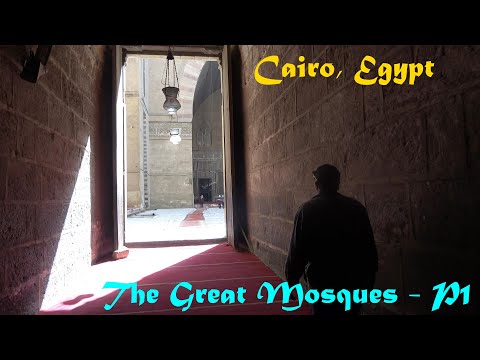In the heart of historic Cairo, the Mosque of Sultan Hassan stands tall. It’s a symbol of the Mamluk era’s architectural beauty. Built from 1356 to 1363, it’s seen as one of the world’s most stunning Islamic buildings. But why does it draw in visitors from everywhere?
The Mosque of Sultan Hassan is a true wonder. It shows the Mamluk dynasty’s big impact on Islamic architecture. Its huge size, new design, and detailed decorations make it a top example of Mamluk skill.
Key Takeaways
- The Mosque-Madrasa of Sultan Hasan is a 14th-century Islamic architectural complex in Cairo, Egypt.
- It was made by Sultan an-Nasir Hasan and built from 1356 to 1363 during the Bahri Mamluk period.
- The mosque is famous for its huge size. It’s about 150 meters long, 68 meters wide, and 36 meters tall.
- Its design and decorations show the Mamluk’s skill and impact on Islamic art.
- The Mosque of Sultan Hassan is one of Cairo’s most impressive historic sites. It shows the city’s deep cultural heritage.
Introduction to the Mosque of Sultan Hassan
The Mosque of Sultan Hassan is in the heart of Islamic Cairo. It shows the beauty and importance of the Mamluk era. Built from 1356-1363 CE, it covers about 8,000 square meters. This makes it one of the biggest and most stunning mosques in Cairo.
Location and Historical Significance
The mosque is near the famous Citadel of Cairo. It has a great view from the Sultan’s palace. Before, a grand palace stood there, built by Sultan al-Nasir Muhammad, the father of Sultan Hassan. This shows its deep history and cultural value in Cairo.
Architectural Grandeur and Innovation
The Mosque of Sultan Hassan is a top example of Mamluk Architecture in Cairo. It’s huge, measuring 150 meters long, 68 meters wide, and 36 meters tall. It has many new features, like eight windows on each side that make it look even taller.
It also has a special cornice of muqarnas that sticks out 1.5 meters. This is a unique Mamluk style that makes the mosque stand out.
| Architectural Specifications | Measurement |
| Total Surface Area | 7,906 square meters |
| Length of Longest Side | 150 meters |
| Height of Northern Portal Façade | 38 meters |
| Height of Southern Minaret | 81.60 meters |
| Number of Madrasas | Four |
| Mausoleum Dome Height | 48 meters |
| Tiers of Muqarnas Cornice | Nine |
| Length of Mausoleum Sides | 21 meters |
The Patron: Sultan an-Nasir Hasan
Sultan an-Nasir Hasan was a key ruler in Egypt’s Mamluk Sultanate. He became ruler at just 13 years old in 1347 CE. His time in power was filled with challenges and big dreams.
Rise to Power and Turbulent Reign
At first, Sultan an-Nasir Hasan faced many power struggles. When he turned 18 in 1350, he took action. He arrested Emir Manjaq, who had too much power.
This move made many officials unhappy. Later, these officials put the Sultan in jail for three years. They made his brother, as-Salih Salih, the new ruler.
While in jail, the Sultan focused on learning. After his release, he tried to change the government to gain more power.
Extravagance and Ambition
Sultan an-Nasir Hasan loved spending a lot of money. Historians like Ibn Kathir criticized him for being too greedy. He used public money for his lavish projects.
He built the Sultan Hasan Mosque with money taken from his people and the wealth of some Mamluks who died from the plague. He wanted to finish the mosque, even if it cost a lot. He said stopping the project would be a shame for Egypt.
| Reign | Accession Age | Commission of Architectural Works | Family | Promotion of Awlad al-Nas | Demise |
| 1347-1351 and 1355-1361 | 12 years old | Sultan Hasan Mosque-Madrasa complex in Cairo, religious structures in Cairo, Jerusalem, Gaza, and Damascus | 11 sons and 6 daughters with wife Tulubiyya | Promoted descendants of mamluks (awlad al-nas) to key positions in administration | Killed at age 27 by one of his own mamluks, Yalbugha al-Umari, who opposed his policy of granting authority to the awlad al-nas |
Construction and Funding
The Mosque-Madrasa of Sultan Hasan is a stunning sight in Cairo. It took from 1356 to 1363 CE to build. Work started in 1356 and went on for three years without stopping. It finished after the sultan died in 1363.

Building Process and Massive Scale
Building the Mosque of Sultan Hassan was huge, both in size and cost. It cost 30,000 dirhams a day to build, making it the priciest mosque in medieval Cairo. The plague made finding workers hard, but it wasn’t the main problem.
Resources and Financial Challenges
The mosque got its money from several sources. Before Sultan Hasan ruled, Emir Manjaq made the state more efficient. The plague also brought in more wealth by killing many Mamluk amirs. The sultan’s rule also took money from his people. But, the project’s high cost, over one million dinars, made the sultan doubt it at times.
| Construction Timeline | Cost of Construction | Architectural Grandeur |
| Construction began in 1356 CE and was completed in 1363 CE. | The daily cost of construction was 30,000 dirhams, making it the most expensive mosque ever built in medieval Cairo. | The Mosque-Madrasa of Sultan Hasan covers an area of 7,906 square meters, with walls rising to a height of 36 meters and the tallest minaret standing at 68 meters. |
Architectural Features
The Mosque-Madrasa of Sultan Hasan is a stunning example of Mamluk-style design. It has beautiful exteriors and interiors. The mosque shows the amazing skills of the Mamluk era in art.
Exterior Design and Façades
The mosque’s southwestern and northeastern facades have eight windows each over four stories. This makes the building look tall. The walls have a special cornice of muqarnas that stick out 1.5 meters, adding beauty.
The corners have columns with special capitals and a twisted design. This shows the influence of Byzantine architecture.
Interior Layout and Decorative Elements
The inside of the mosque is just as beautiful. It has stunning stained glass windows and walls with Islamic calligraphy. The madrasa has classrooms and the mausoleum is decorated with mosaics, some of which are still there.
“The Mosque-Madrasa of Sultan Hasan is a true masterpiece of Mamluk style, blending architectural innovation with exquisite decorative elements and Islamic calligraphy.”
This mosque shows the amazing skills of the Mamluk era. It gives us a look at the mosque architecture and exterior design of that time in Islamic history.
The Mosque of Sultan Hassan in Context
The Mosque-Madrasa of Sultan Hasan is a top example of Mamluk architecture. It has greatly influenced Islamic design in Cairo and beyond. Its unique features like vertical windows and a special cornice are key parts of the Mamluk style.
It was built from 1356 A.D. to 1363 A.D. The mosque is huge and beautifully decorated. It shows the wealth and ambition of the Mamluk rulers. The mosque is big, with walls that go up 36 meters high. Its front wall is 145 meters long and 38 meters tall.
Building this mosque was so big an effort, it almost emptied the Mamluk Treasury. But, it turned out to be a masterpiece. It inspired many other big mosques and madrasas in the city.
Influence of Mamluk Architecture
The Mosque of Sultan Hasan introduced new design elements. These include vertical windows and a special cornice. These features became key parts of Mamluk architecture in Cairo.
- The mosque’s size and beauty led to the building of more big religious places in the city.
- Its central courtyard with four teaching areas became a common design for Mamluk mosques and madrasas.
- The beautiful fountain in the courtyard, added later, shows the mosque’s lasting impact.
- The mausoleum of Sultan Hasan, with its detailed art, set a standard for royal tombs.
The Mosque-Madrasa of Sultan Hasan shows the skill and culture of the Mamluk era. It still amazes visitors and scholars as a top example of Islamic design in Cairo.
Later History and Preservation

The Mosque-Madrasa of Sultan Hasan has been a key part of Cairo’s look for a long time. But, it faced many challenges. It’s near the Citadel, so it was often used for battles. This led to many attempts to destroy it, like by Sultan Barquq in 1391 and Sultan Janbalat in 1500.
In 1517, the last Mamluk sultan, Tumanbay, hid in the mosque to avoid the Ottoman army. The Ottomans then attacked the mosque with cannons. Yet, the mosque has made it to today, showing its strength and the efforts to save it.
Restoration and Conservation Efforts
Over time, the Mosque-Madrasa of Sultan Hasan has been fixed up to keep its look. In 1659, a minaret fell down. Then, from 1671-1672, a new, smaller minaret was built. The wooden dome in the mausoleum was also replaced back then.
Recently, in the late 1800s and early 1900s, big efforts were made to save this architectural and historical monument. Workers fixed up domes, minarets, and decorations. This helped keep the Mosque History and Architectural Heritage of the Sultan Hassan Mosque alive.
“The Mosque-Madrasa of Sultan Hasan has survived to the present day, a testament to its sturdy construction and the efforts of those who sought to preserve this architectural heritage.”
Keeping the Sultan Hassan Mosque safe has been important to many rulers. Restoration Efforts and Conservation have been key. They help keep this Mosque History alive. They also show the Mamluk-Ottoman Struggles and Mosque Preservation in Cairo.
Visiting the Mosque of Sultan Hassan
The Mosque-Madrasa of Sultan Hasan is a key spot in Cairo. It draws visitors from all over to see its stunning Mamluk architecture. It’s open every day from 9 am to 4 pm. This place lets travelers dive deep into Cairo’s cultural history.
When you visit the Mosque of Sultan Hassan, you must dress modestly and take off your shoes. The cost to get in is just 50 EGP (about USD 3). This lets you see the mosque’s beauty inside and enjoy views of Cairo from the madrasa’s rooftop.
The mosque is huge, covering 8,000 square meters. It took seven years to build, from 1356 to 1363. This shows the skill and wealth of the Mamluk time. They spent 30,000 dirhams every day on it.
| Visiting Information | Details |
| Opening Hours | 9 am to 4 pm daily |
| Entrance Fee | 50 EGP (around USD 3) |
| Dress Code | Modest attire, shoes must be removed |
| Highlights | Mamluk architecture, panoramic city views from the madrasa rooftop |
The Mosque of Sultan Hassan is a symbol of Cairo’s Mamluk architecture. It gives visitors a peek into the city’s past and the beauty of its historic sites.
Cultural and Historical Significance
The Mosque-Madrasa of Sultan Hasan is a key example of Mamluk architecture. It shows the lasting impact of Islamic design in the area. Its unique features like vertical windows and muqarnas cornice made it famous. This style was copied in many other buildings in Cairo and beyond.
This mosque’s size and beauty showed the wealth and dreams of Mamluk rulers. It became a symbol of Cairo’s heritage and the Islamic cultural significance of the region. Today, it is one of the best-preserved Mamluk sites in Cairo. It still amazes visitors and makes locals proud.
Influence on Islamic Architecture
The Mosque-Madrasa of Sultan Hasan’s design, with its vertical windows and muqarnas cornice, changed Islamic architecture. It inspired many mosques and buildings in Cairo and nearby. This architectural legacy greatly influenced Islamic design in the region.
Symbol of Cairo’s Heritage
This mosque is a key piece of Cairo’s rich cultural and historical heritage. It’s very popular with tourists. This shows its importance as a loved landmark and a source of pride for Cairo‘s people.
| Architectural Feature | Significance |
| Vertical Window Rows | Became a hallmark of Mamluk architectural style |
| Projecting Muqarnas Cornice | Inspired the design of numerous other Mamluk buildings |
| Massive Scale and Lavish Decoration | Set a new standard for Mamluk rulers’ ambition and wealth |
“The Mosque-Madrasa of Sultan Hasan is not only an architectural masterpiece but also an important symbol of Cairo’s rich cultural and historical heritage.”
Conclusion
The Mosque-Madrasa of Sultan Hasan is a true architectural wonder. It shows the grandeur of the Mamluk era in Cairo. Its huge size, new design, and rich decorations highlight the achievements of that time.
This mosque is a top spot for tourists in Cairo. It’s a symbol of the city’s deep culture and history. Its impact on Islamic architecture makes it a gem and a sign of the Mamluk sultanate’s great work.
Egypt works hard to keep the Mosque-Madrasa of Sultan Hasan safe and looking great. As a UNESCO World Heritage Site, it draws visitors worldwide. It lets them see the beauty of Mamluk architecture and Cairo’s lively history.
Read our related articles:


